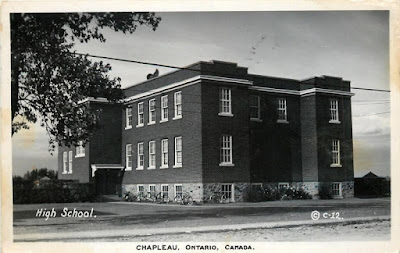 |
| JASON RIOUX |
Ian's continuing interest in Chapleau reminds me of the maxim that you can take the boy (or girl) out of Chapleau, but you can't take Chapleau out of them!!!! Thank you so much Ian. MJM
BY IAN MACDONALD
Chapleau, Ontario was recently the centre of international attention at the 2019 National Trust Conference held in Winnipeg from October 17 to 19. One of the main conference events was recognition of a selected number of significant heritage projects in Canada including the remarkable efforts of Jason Rioux in transforming St. John’s Church in Chapleau into a vibrant, socially useful and profitable facility.
The National Trust for Canada in association with the Canadian Association of Heritage Professionals function as major advocates for promoting Canadian heritage including historic architecture, artifacts, landscapes and a multitude of specialized areas including railway heritage. Planning and community development across the country now includes heritage as a major factor in developing healthy and sustainable communities. Major international meetings such as the Winnipeg conference provide an opportunity for a wide range of successful project case studies to be presented, discussed and honoured.
Conferences of this type remain an important part of keeping abreast of the times for planners and designers. Despite to-day’s ease of access to information, there is still no substitute for sharing experience on a personal basis. Jason Rioux, in addition to the formalities of receiving his award also had the opportunity to present the Chapleau St. John’s project in two working sessions where lessons and problem-solving strategies were shared.
Transformation from St. John’s Anglican Church to “The Hub”
The important historic cultural role of St. John’s Anglican church cannot be understated. Thanks to Michael Morris’ articles and publications, the history of the church is generally well known. The Anglicans established themselves in Chapleau even prior to the completion of the Canadian Pacific Railway in 1885 with services being conducted in such unlikely places as an empty boxcar and a partially completed railway depot. The first permanent church structure which was opened and consecrated on July 1 1886 was located on the south west corner of Pine and Young St. The rapidly growing community, however, would soon generate a demand for a much larger church to be built opposite the original. Plans for the building were thus developed in 1905 and construction was completed on March 29, 1908 at a cost of $18,000.00. St. John’s, in addition to serving the spiritual needs of the community, functioned in a broader role as the pro-cathedral of the Diocese of Moosonee until 1913. It would gradually play a significant and integral part of the cultural life of the community for the next century.
The church is a classic heritage building originally built in the traditional gothic revival style which was consistent with Anglican churches of the day constructed of masonry bearing walls on a rubble stone foundation. The roof structure is a vaulted timber joist roof assembly supported by distinctive specially fabricated timber hammer trusses. Interiors of the church were elegantly finished and carefully restored in the 1950’s. The basement area which was known then as Renison Hall functioned as a church hall and was used for a variety of community social activities. The church itself could accommodate congregations of over 250 parishioners.
Changing economic conditions coupled with unfortunate ideological division within the broader national Anglican community led to a steady decline in church membership beginning in the 1960s. The dwindling congregation thus found it increasingly difficult to generate funds necessary to
to maintain a building of this size properly.
Specialized work would be required to replace mechanical, heating and ventilation equipment and rehabilitate the building to allow it to accommodate new uses and meet more stringent building code requirements. Unfortunately, neither the Anglican Church of Canada nor the Township of Chapleau was prepared to step up and take responsibility and demolition seemed to be the only option. The challenge for Jason Rioux upon acquiring the building was to retain the original spirit of the building while adapting it to new purposes. The financial risk in addition to the business acumen necessary to develop a strategy for creative and innovative rehabilitation were all factors in selecting the project as an award winner.
Heritage can be a complex factor in the planning and development of communities and not always completely understood and appreciated. We are too easily prone to defaulting to demolition as an easy fix rather than face up to the more complicated task of rehabilitation. Architecture, since the earliest human settlements, has provided commodity and shelter but has at the same time been an enduring expression of cultural beliefs and values.
It is an expression of who we are. Buildings like St. John’s, in this sense, are important historical markers in this case expressing a particular set of Christian values and beliefs of the era. St. John’s along with the other Chapleau churches have co-existed beside one another reflecting a community of diverse cultural backgrounds and values. The fact that beliefs and values change over time does not automatically render something obsolete that has to be destroyed. Buildings, like all of us, can be transformed and adapt to modified values and conditions. Jason Rioux was cited nationally for his personal courage in absorbing financial risk and for mustering the imagination and innovation required to make the Hub project a reality.
Video Link https://www.youtube.com/watch?v=VY-pbRvLr6k&feature=youtu.be







